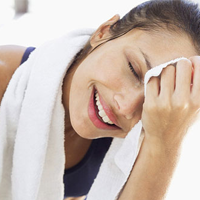Common Herb Proven to Reduce Excessive Sweat

Could an ordinary common kitchen herb really reduce excessive sweat?
Hyperhidrosis sufferers reading this will certainly hope so.
Hyperhidrosis is the medical term for excessive sweating far beyond what the body needs to do to control body temperature. It results in moisture laying on the surface of the skin instead of evaporating like it normally would.
Some sufferers have problems with grip because of near-permananet wet hands and others need to have several changes of clothing each day. It usually affects the hands and feet but can extend to other parts of the body including the head, trunk and under arms.
Treatment is limited to Iontophoresis (using electric currents to disrupt the sweat glands), Botox injections and a surgical procedure called endoscopic thoracic sympathectomy (ETS)whereby the nerves serving the sweat glands are blocked or cut.
None of these treatments are without risks and all are very expensive. Their effectiveness also seems to vary from patient to patient and and horror stories are common – particularly relating to the surgical option (which requires each lung to be collapsed in turn in order to reach the nerves in the chest cavity).
Clearly then, the prospect of a totally natural, risk-free treatment involving an inexpensive kitchen herb will be greated heartily by anyone with an excessive sweat problem – particularly when the herb in question has actually been medically proven.
The treatment, tested by a group of researchers at the School of Medicine, Isfahan University of Medical Sciences in Iran, is a simple “tea” solution made from the dried leaves of a common herb, and water.
In the medical study, thirty-five patients (18 men and 17 women, aged 8-49 years) who had been diagnosed with either palmar or plantar (hand or foot) hyperhidrosis were given the treatments three times a day for six weeks.
The solution was simply applied to the skin (they didn’t drink it) where excessive sweating was a problem. After six weeks of this treatment the people in the study who received the tea experienced significantly more relief from their sweating than the people who were given a placebo.
In fact, the solution was shown to reduce sweating in the hands, feet and under arms by as much as 37% as a result of the herb’s astringent properties.
These are the directions if you want to make the solution at home…
Use three spoonfuls of dried leaves mixed with 250 ml (8.5 ounces) of room temperature water and leave to steep for 24 to 48 hours.
After straining, the resulting solution can be applied to underarms, hands or feet. The researchers also suggest a further treatment for plantar hyperhidrosis which affects the soles of the feet. They recommend a dry powder of the herb, placed in the shoes. The powder can be made by grinding dried leaves with an electronic or hand mill.
The solution or powder should be applied to the problem area three times a day and the area should be completely dried before application.



